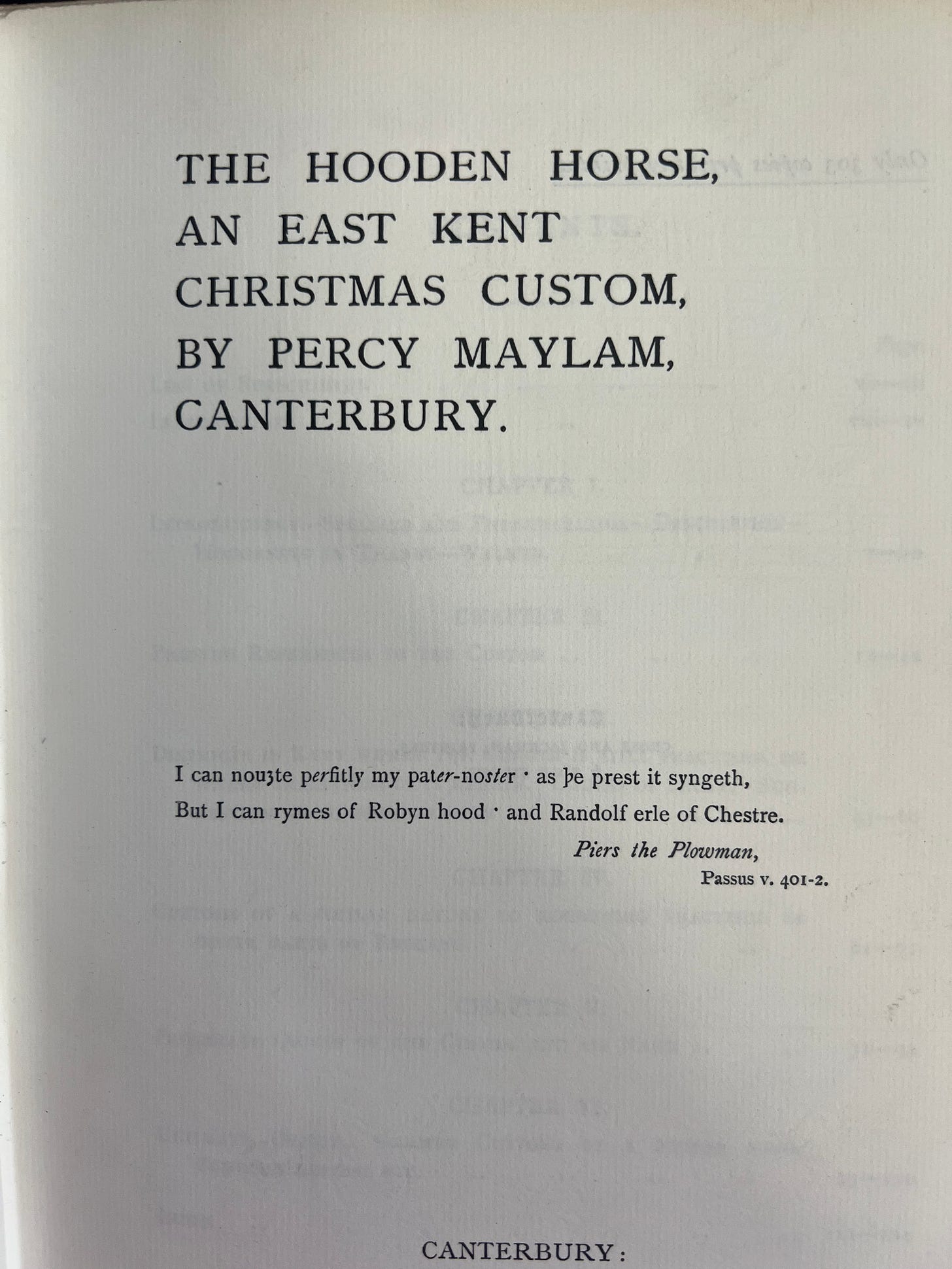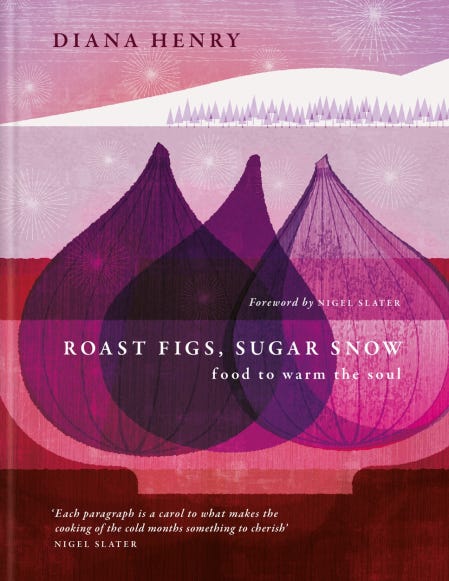Winter reads: an alternative guide
Sharing favourites from my winter bookshelf
Hello,
One of the things I love about the run-up to Christmas is the proliferation of book guides - I am absolutely here for everyone’s books of the year, from a variety of different angles, and delving into a plethora of genres.
But I am hopeless at remembering what I’ve read in any given year (I realise that sensible people keep a list in the back of their diary), so this is unlikely to ever feature in these pages. Instead, I thought I’d offer you some choice cuts from my hoard of midwinter books, a collection that grows every year. Here are some of the more unusual ones.
The Shaker Order of Christmas
Edward and Faith Andrews
Oxford University Press, 1954
Unlike many other Christian sects, the Shakers kept Christmas, and this little booklet recounts how that came to be. At midwinter 1776, church member Hannah Hocknell got up one snowy morning and found herself unable to lace her shoes due to a peculiar ‘shaking or agitation of the limbs’ which was witnessed by the prophetess, Mother Ann. ‘Try no longer, Hannah,’ she said; ‘put off the shoes from thy feet, for the place whereon thou standest is holy ground.’
This was the sign that told the Shakers to celebrate Christmas, the gift of a day without manual labour, but which was devoted to spiriutal cleaning instead. The Order of Christmas was born, instructing Shakers on how to behave, what to sing and what to wear on Christmas Day.
My edition is designed by John Begg and illustrated by Gloria Granger. You can read it on the Internet Archive here.
Ancient English Christmas Carols 1400 - 1700
Collected and arranged by Edith Rickert
Chatto & Windus, 1910
I have a few collections of carols, but this one is my favourite. Edith Rickert was a Professor of English at the University of Chicago, and an expert in Chaucer who gained her PhD in 1899. Over the course of her long career, she also wrote novels and served as a WWI codebreaker.
This meticulous collection came before all that, and is one of the most useful books for understanding the deep history of carolling. In her introduction, Rickert argues that many of the Christian lyrics would have been substituted into songs from the more distant pagan past, when people celebrated ‘mid-wintermass’ which she says was ‘celebrated with a blending of riot and sacrifice to tribal divinities.’ From the evidence of this book, a lot of those celebrations were focused on food and ale.
You can read it on Internet Archive.
Winter in Majorca (with José Quadrado’s Refutation of George Sand)
George Sand, translated and annotated by Robert Graves
Valledemosa Edition Mallorca, 1956
In 1838, the French novelist George Sand - a pen name for Amantine Lucile Aurore Dupin de Francueil - moved to Mallorca to spend a winter with her lover, the composer Frederic Chopin. With Sand’s two children, they stayed in the Carthusian monastary of Valldemossa, hoping that the climate would improve Chopin’s tuberculosis. Instead, he sickened further, and in February 1838 they moved on.
Winter in Mallorca is an autobiographical novel based on that time, in which Sand portrays herself as a male friend of Chopin’s. It is fair to say that Sand did not endear herself to the Mallorcans; she portrays them as lazy, weak and dirty with no intellectual culture. In his ‘refutation’ of Sand’s account, José Quadrado notes that “Majorcan ladies were happy to leave her, being (if you like) backward enough to place morality before cleverness, and to honour themselves with the title of ‘wife’ rather than ‘authoress’.” Ouch.
The Famous Tragedy of the Queen of Cornwall
Thomas Hardy
Macmillan, 1923
This is not specifically a book about winter, but it is a mummers’ play, a dramatic form associated with the revels of midwinter. Written for The Hardy Players, a Dorchester theatre company for whom Hardy adapted a number of his novels, it was first performed in 1923.
Mummers are troupes of amateur actors who traditionally performed at moments of festivity across the year, presenting a repertoire of rowdy plays with a cast of characters who often include St George, the devil, Father Christmas, Robin Hood and a dragon. They are a little like pantomimes in that they encourage audience participation, and can be adapated to include satire and jokes referring to current events. First recorded in the eighteenth century, they are currently undergoing a revival in England, as well as a much-needed update in their political attitudes (for example, the use of blackface was banned in 2017).
The Tragedy of the Queen of Cornwall was Hardy’s final published work, written entirely in verse at the age of 83. It is a chivalric romance, telling the story of Sir Tristram and Iseult, Queen of Cornwall, requiring, as the original frontispiece states, ‘no theatre or scenery.’
The Hooden Horse, An East Kent Christmas Custom
Percy Maylam
Cross and Jackman, 1909
I admit that this book is extremely local and specific to my interests (only 303 copies were published, and every recipient is named in the front pages), but it has such excellent photographic plates that I can’t resist sharing it with you.
The Hooden Horse is a Kentish folk custom in which groups of musicians travel between houses and pubs with a hoodener - a man disguised as a horse, with a wooden head and clacking jaw. They played music and games, which included trying to ride the horse and getting thrown off, and were paid in money and beer. It’s part of the long tradition of midwinter table-turning and misrule, which has recently been revived in a slightly more polite and less transgressive form.
The Hooden Horse has close relatives in the Welsh Mari Lwyd and the Cornish ‘Obby ‘Oss, creatures that speak of otherness and boundary-pushing. As you can see from the photographs, it definitely carries an uncanny quality about it, but there’s also a clear sense of pride exuding from the hoodeners. If you ever get a chance to meet it in real life, usually in deepest Kent somewhere between the winter solstice and New Year, don’t miss it.
I suppose it’s not the most festive selection, but hopefully it’s interesting instead! I’d love to hear about your favourite midwinter reads - weird or otherwise - in the comments.
Earlier this week, I was tagged in Nicola Croft’s ‘avoidance of stuff’ Christmas gift guide, and I liked it so much that I thought I’d share it here. It contains some brilliant ideas for giving experiences or things that are so useful that they can’t possibly be regifted, including Substack subscriptions. Mine are available here, and you can also gift a Retreat subscription - which includes four online retreats per year and a welcome pack with a signed bookplate - here. We’ll make sure it gets addressed to the right person!
Take care,
Katherine
Coming up at The Clearing
Events for paid subscribers
December’s True Stories Book Club with Diana Henry talking about Roast Figs, Sugar Snow
When it comes to cold-weather cooking, Diana Henry’s Roast Figs, Sugar Snow is just the book to turn to. She’ll be joining me to talk about winter recipes and how she navigates the darker months.
20th December, 7pm UK
January’s True Stories Book Club with Sharon Salzberg talking about Finding Your Way
I’ll be chatting with the always-wise Sharon Salzberg about her book of meditations to find gentler suggestions for New Year reform than all those punitive resolutions.
11th January 2024, 7pm UK
If you think a friend or loved one would enjoy The Clearing by Katherine May, gift subscriptions are available here | Website | Buy: Enchantment UK /US | Buy: Wintering UK / US | Buy: The Electricity of Every Living Thing UK / US
This newsletter may contain affiliate links.














I LOVE these recommendations--thank you so much for sharing these rare gems from your shelf. I'm fascinated by those earlier traditions around the winter solstice, and those hooden horse images are so wonderful. The old are as needed as the new, and this post shows why. 💜
These are so wonderful. What a treat, thank you.